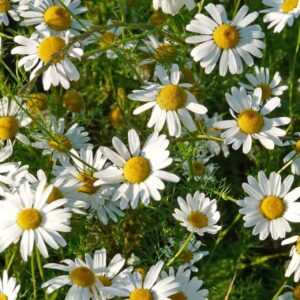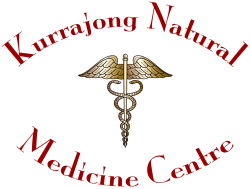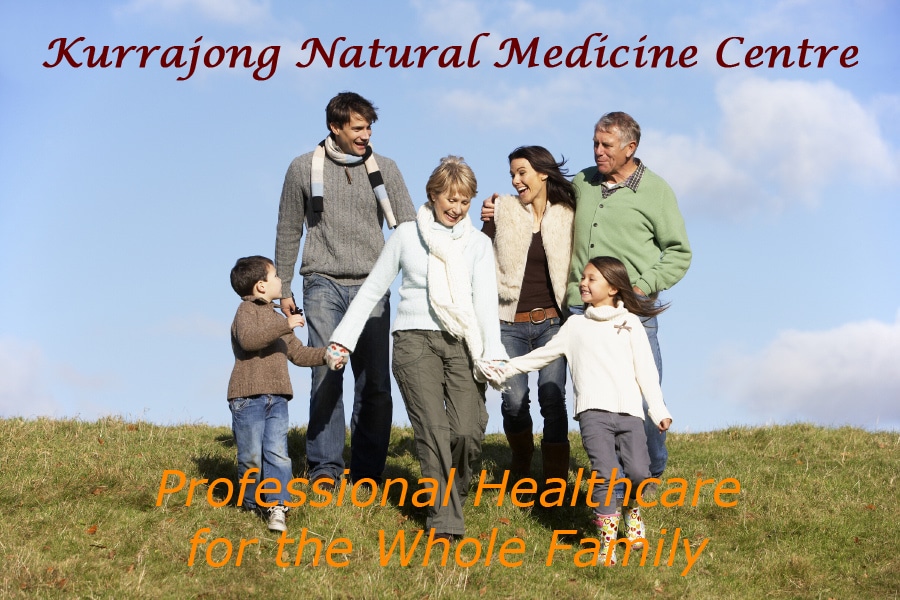Medicinal Herb: German Chamomile
Medicinal Herb: German Chamomile
German Chamomile
Biological Name:
(Matricaria chamomilla, M. chamomilla)
Family:
Asteraceae
Other Names:
Camomile, matricaria, anthemis, ground apple, Roman camomile, garden camomile, low camomile, whig plant, German camomile, wild camomile.

Introduction to German Chamomile:
Chamomile is a widely recognised herb in Western culture. Its medicinal usage dates back to antiquity where such notables as Hippocrates, Galen, and Asclepius made written reference to it. A common ingredient today in herbal teas because of its calming, carminative, and spasmolytic properties, it is also a popular ingredient in topical health and beauty products for its soothing and anti-inflammatory effects on skin. Chamomile has a sweet, grassy, and lightly fruity aroma. Its flowers are daisy-like, with yellow centres (approximately 1-1.5 cm in diameter) and white petals (between 12-20 in number). It is from the plant’s fresh and dried flower heads that infusions, liquid extracts, and essential oils are made[1].
Chamomile scientifically known as Matricaria chamomilla, is a flowering plant that belongs to the Asteraceae family. It is native to Europe and Western Asia but is now cultivated in many parts of the world, including North America.
German chamomile is widely recognised for its medicinal properties and is commonly used in traditional herbal medicine. The plant has delicate, daisy-like flowers with white petals and yellow centers. It grows to a height of about 15-60 cm (6-24 inches) and has a strong, pleasant aroma.
The flowers of German chamomile are the main part used for medicinal purposes. They are harvested and dried to make chamomile tea or extracted to produce essential oil. The essential oil contains various compounds, including chamazulene, which is responsible for the blue color of the oil and has anti-inflammatory properties.
Chamomile is known for its calming and soothing effects, both internally and externally. It is commonly used to promote relaxation, relieve stress, and aid in sleep. Chamomile tea is often consumed as a natural remedy for insomnia, anxiety, and digestive issues like indigestion, bloating, and gas.
In addition to its calming properties, German chamomile has been used topically for centuries to soothe skin irritations and promote wound healing. It can be applied as a diluted essential oil or used in the form of creams, ointments, or compresses to alleviate skin conditions such as eczema, psoriasis, and minor burns.
It’s important to note that while German chamomile is generally considered safe for most people, it can cause allergic reactions in some individuals, especially those with known allergies to plants in the Asteraceae family, such as ragweed. If you have any concerns or specific health conditions, it’s best to consult with a healthcare professional before using German chamomile for medicinal purposes.
Detailed Botanical Description
Flowers: The flowers are characterized by their white ray florets and yellow disc florets in the center. They bloom in the early summer and have a distinctive apple-like fragrance.
Leaves: The leaves are bipinnate or tripinnate, light green, and have a feathery appearance.
Seeds: Chamomile seeds are small and need light to germinate, which is why they are usually sown directly on the soil surface.
Growing and Harvesting
Matricaria chamomilla, usually referred to as chamomile, is a well-known medicinal plant from the Asteraceae family. It is an annual herb that grows on all soil types and is resistant to cold. Chamomile is native to southern and eastern Europe and northern and western Asia.
Planting: German chamomile is typically sown in spring. It prefers light, well-drained soil and can even thrive in poor, sandy soil.
Harvesting: Flowers are harvested when they are fully open. The timing of harvest is crucial to ensure the highest quality and potency of the essential oils.
Active Constituents in Chamomile:
The flowers of chamomile provide 1-2% volatile oils containing alpha-bisabolol, alpha-bisabolol oxides A & B, and matricin (usually converted to chamazulene). Other active constituents include the bioflavonoids apigenin, luteolin, and quercetin.
These active ingredients contribute to chamomile’s actions and include: antibacterial, antifungal, anti-inflammatory, antispasmodic, anti-ulcer, anti-viral, sedative effects, and smooth muscle-relaxing effects, particularly in the gastrointestinal tract[1,2].
Traditional Applications of German Chamomile in Herbal Medicine:
- Blocked tear duct
- Canker sores (mouth ulcers)
- Colic
- Diarrhoea
- Eczema
- Gingivitis (periodontal disease)
- Indigestion and heartburn
- Insomnia
- Irritable bowel syndrome
- Peptic ulcer
- Skin irritations
- and others
1. Calming and Relaxation:
- Herbal Tea: Chamomile tea is perhaps the most well-known application. It has been traditionally consumed to induce relaxation, alleviate stress, and promote better sleep. The mild sedative properties of chamomile are believed to have a calming effect on the nervous system.
2. Digestive Health:
- Indigestion and Gas: Chamomile has been used to ease digestive discomfort, including indigestion and gas. Drinking chamomile tea after meals may help soothe the digestive tract.
3. Anti-Inflammatory Properties:
- Topical Compresses: Chamomile’s anti-inflammatory properties have been harnessed in traditional medicine for treating skin conditions. Compresses or poultices made from chamomile tea or chamomile essential oil have been applied topically to reduce inflammation, soothe skin irritations, and promote wound healing.
4. Women’s Health:
- Menstrual Discomfort: Chamomile tea has been traditionally used to ease menstrual cramps and discomfort. Its mild muscle-relaxant properties may contribute to this effect.
5. Respiratory Health:
- Inhalation: Inhaling the steam from chamomile tea or essential oil has been a traditional remedy for respiratory issues. It is believed to help relieve symptoms of colds, coughs, and sinus congestion.
6. Oral Health:
- Mouthwash: Chamomile’s anti-inflammatory and antibacterial properties have led to its use in oral hygiene. Rinsing with chamomile tea may help soothe gum inflammation and promote oral health.
7. Anti-Anxiety and Stress Reduction:
- Aromatherapy: The aroma of chamomile essential oil is traditionally used in aromatherapy to reduce anxiety and stress. It is often diffused or added to bathwater for a relaxing effect.
8. Eye Health:
- Eye Compresses: Chamomile tea bags have been applied as compresses to soothe tired or irritated eyes. The anti-inflammatory properties of chamomile may help reduce redness and puffiness.
9. Infant Care:
- Colic Relief: Chamomile tea has been used traditionally to alleviate symptoms of colic in infants. Its gentle nature makes it suitable for young children.
10. Hair Care:
- Rinses: Chamomile infusions have been used as hair rinses to enhance shine and lighten hair color. It is believed to have conditioning effects on the hair and scalp.
11. Anti-Allergenic Applications:
- Allergy Relief: Some traditional medicine systems have used chamomile to alleviate symptoms of allergies, such as hay fever. Its anti-inflammatory properties may contribute to reducing allergic responses.
12. Joint and Muscle Pain:
- Topical Applications: Chamomile-infused oils or creams have been applied topically to soothe joint and muscle pain. The anti-inflammatory and analgesic properties are thought to contribute to pain relief.
Recent research has shown German chamomile to be effective in the treatment of other conditions including: Diabetes, Mouth ulcers, mucositis, and gingival bleeding, Osteoarthritis of the knee, Premenstrual syndrome, and Ulcerative colitis [3].
Using German Chamomile in Essential Oil and Aromatherapy
Extraction: The essential oil is extracted primarily from the flowers through steam distillation.
Uses in Aromatherapy: German chamomile oil is used for its calming effect in aromatherapy, helping to alleviate anxiety, stress, and promote relaxation.
Skin Care Applications: The oil is used in creams and lotions for its anti-inflammatory and soothing properties, beneficial for sensitive or irritated skin.
Dietary and Culinary Uses
Scientific Information on German Chamomile
The Following is the Abstract from the Journal Article on Chamomile pulished in Life (Basel):
ABSTRACT:
Matricaria chamomilla L. is a famous medicinal plant distributed worldwide. It is widely used in traditional medicine to treat all kinds of diseases, including infections, neuropsychiatric, respiratory, gastrointestinal, and liver disorders. It is also used as a sedative, antispasmodic, antiseptic, and antiemetic. In this review, reports on M. chamomilla taxonomy, botanical and ecology description, ethnomedicinal uses, phytochemistry, biological and pharmacological properties, possible application in different industries, and encapsulation were critically gathered and summarised. Scientific search engines such as Web of Science, PubMed, Wiley Online, SpringerLink, ScienceDirect, Scopus, and Google Scholar were used to gather data on M. chamomilla.
The phytochemistry composition of essential oils and extracts of M. chamomilla has been widely analyzed, showing that the plant contains over 120 constituents. Essential oils are generally composed of terpenoids, such as α-bisabolol and its oxides A and B, bisabolone oxide A, chamazulene, and β-farnesene, among other compounds. On the other hand, M. chamomilla extracts were dominated by phenolic compounds, including phenolic acids, flavonoids, and coumarins. In addition, M. chamomilla demonstrated several biological properties such as antioxidant, antibacterial, antifungal, anti-parasitic, insecticidal, anti-diabetic, anti-cancer, and anti-inflammatory effects.
These activities allow the application of M. chamomilla in the medicinal and veterinary field, food preservation, phytosanitary control, and as a surfactant and anti-corrosive agent. Finally, the encapsulation of M. chamomilla essential oils or extracts allows the enhancement of its biological activities and improvement of its applications.
According to the findings, the pharmacological activities of M. chamomilla confirm its traditional uses. Indeed, M. chamomilla essential oils and extracts showed interesting antioxidant, antibacterial, antifungal, anticancer, antidiabetic, antiparasitic, anti-inflammatory, anti-depressant, anti-pyretic, anti-allergic, and analgesic activities. Moreover, the most important application of M. chamomilla was in the medicinal field on animals and humans.
References
1. Matricaria chamomilla, Alternative Medicine Review Volume 13, Number 1 March 2008
2. Stuart, Malcolm. (1979). The Encyclopedia of herbs and herbalism. London : Orbis Books
Disclaimer
Disclaimer information for users of the Kurrajong Natural Medicine Centre, Namaste Yoga Kurrajong and The Herbal Health Coach website.
Page last updated: 26th June 2020
Information provided for education and research information only
The information on this website is presented by Kurrajong Natural Medicine Centre for the purpose of disseminating health information free of charge for the benefit of the public.
While Kurrajong Natural Medicine Centre has exercised due care in ensuring the accuracy of the material contained on this website, the information on the site is made available on the basis that Kurrajong Natural Medicine Centre is not providing professional advice on a particular matter.
This website is not a substitute for independent professional advice. Nothing contained in this site is intended to be used as medical advice and it is not intended to be used to diagnose, treat, cure or prevent any disease, nor should it be used for therapeutic purposes or as a substitute for your own health professional’s advice.
Kurrajong Natural Medicine Centre does not accept any liability for any injury, loss or damage incurred by use of or reliance on the information provided on this website.
Quality of information
Kurrajong Natural Medicine Centre makes every effort to ensure the quality of the information available on this website and updates the information regularly. Before relying on the information on this site, however, users should carefully evaluate its accuracy, currency, completeness and relevance for their purposes, and should obtain any appropriate professional advice relevant to their particular circumstances. Kurrajong Natural Medicine Centre cannot guarantee and assumes no legal liability or responsibility for the accuracy, currency, completeness or interpretation of the information.
The material may include the views or recommendations of third parties and does not necessarily reflect the views of Kurrajong Natural Medicine Centre or indicate a commitment to a particular course of action.
Links to other websites
This website contains links to other websites which are external to Kurrajong Natural Medicine Centre. Kurrajong Natural Medicine Centre takes reasonable care in selecting linking websites but Kurrajong Natural Medicine Centre accepts no responsibility for material contained in a website that is linked to this site. It is the responsibility of the user to make their own decisions about the accuracy, currency, reliability and correctness of information contained in linked external websites.
Links to external websites are provided for the user’s convenience and do not constitute an endorsement or a recommendation of any third party products or services offered by virtue of any information, material or content linked from or to this site. Users of links provided by this site are responsible for being aware of which organisation is hosting the site they visit.
Views or recommendations provided in linked sites may include the views or recommendations of third parties and do not necessarily reflect those of Kurrajong Natural Medicine Centre or indicate a commitment to a particular course of action. .



